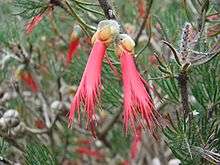Calothamnus sanguineus
| Calothamnus sanguineus | |
|---|---|
 | |
| Calothamnus sanguineus in the Royal Botanic Gardens, Cranbourne | |
| Scientific classification | |
| Kingdom: | Plantae |
| (unranked): | Angiosperms |
| (unranked): | Eudicots |
| (unranked): | Rosids |
| Order: | Myrtales |
| Family: | Myrtaceae |
| Genus: | Calothamnus |
| Species: | C. sanguineus |
| Binomial name | |
| Calothamnus sanguineus Labill.[1] | |
| Synonyms | |
| |
Calothamnus sanguineus, commonly known as silky-leaved blood flower, is a plant in the myrtle family, Myrtaceae and is endemic to the south-west of Western Australia. The Noongar peoples know the plant as Boolgalla.[2] It is an erect to spreading shrub with short, cylindrical leaves and red or white flowers with an unusual arrangement of stamens, often flowering in autumn, winter or spring. It was the first of its genus to be formally described.
Description
Calothamnus sanguineus is a shrub sometimes growing to a height of 2 metres (6.6 ft). Its leaves are 10–20 millimetres (0.4–0.8 in) long, circular in cross section and usually have many long, spreading hairs.[3][4]
The flowers are bright red, sometimes white, and have 4 sepals, 4 petals and 4 claw-like bundles of stamens. The upper two bundles are much broader and longer than the lower two and the upper two are fused for much of their length. (Calothamnus torulosus has similar flowers but the upper stamen bundles are not fused in that species.) Flowering occurs from March to November and is followed by fruits which are woody capsules.[3][4][5]
Taonomy and naming
Calothamnus sanguineus was first formally described by French naturalist Jacques Labillardière in 1806 in Novae Hollandiae Plantarum Specimen from a specimen he collected in the first few months of 1793 during the d'Entrecasteaux expedition.[1][6] In 2014 Craven, Edwards and Cowley proposed that the species be renamed Melaleuca cruenta.[7]
Distribution and habitat
Calothamnus sanguineus is found from Cape Naturaliste to Kalbarri in the Avon Wheatbelt, Esperance Plains, Geraldton Sandplains, Jarrah Forest, Mallee, Swan Coastal Plain and Warren biogeographic regions. It occurs on sandplains, limestone ridges, and granite outcrops.[4]
Conservation
Calothamnus lateralis is classified as "not threatened" by the Western Australian government department of parks and wildlife.[4]
References
- 1 2 "Calothamnus sanguineus". APNI. Retrieved 7 August 2015.
- ↑ "Noongar names for plants". kippleonline.net. Retrieved 26 November 2016.
- 1 2 Hawkeswood, Trevor J. (1984). "Nine new species of Calothamnus Labill. (Myrtaceae: Leptospermoideae) from Western Australia" (PDF). Nuytsia. 5 (1): 124–125. Retrieved 7 August 2015.
- 1 2 3 4 "Calothamnus sanguineus". FloraBase. Western Australian Government Department of Parks and Wildlife.
- ↑ "Calothamnus sanguineus". Australian Native Plants Society Australia. Retrieved 7 August 2015.
- ↑ de La-Billardiere, Jacques Julien (1806). Novae Hollandiae plantarum specimen, Volume 2. Paris. pp. 25–26. Retrieved 7 August 2015.
- ↑ Craven, Lyn A.; Edwards, Robert D.; Cowley, Kirsten J. (30 June 2014). "New combinations and names in Melaleuca (Myrtaceae)". Taxon. 63 (3): 665. doi:10.12705/633.38. Retrieved 7 August 2015.